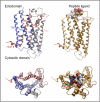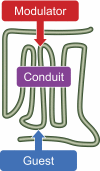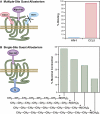Seven transmembrane receptors as shapeshifting proteins: the impact of allosteric modulation and functional selectivity on new drug discovery
- PMID: 20392808
- PMCID: PMC2879912
- DOI: 10.1124/pr.108.000992
Seven transmembrane receptors as shapeshifting proteins: the impact of allosteric modulation and functional selectivity on new drug discovery
Abstract
It is useful to consider seven transmembrane receptors (7TMRs) as disordered proteins able to allosterically respond to a number of binding partners. Considering 7TMRs as allosteric systems, affinity and efficacy can be thought of in terms of energy flow between a modulator, conduit (the receptor protein), and a number of guests. These guests can be other molecules, receptors, membrane-bound proteins, or signaling proteins in the cytosol. These vectorial flows of energy can yield standard canonical guest allostery (allosteric modification of drug effect), effects along the plane of the cell membrane (receptor oligomerization), or effects directed into the cytosol (differential signaling as functional selectivity). This review discusses these apparently diverse pharmacological effects in terms of molecular dynamics and protein ensemble theory, which tends to unify 7TMR behavior toward cells. Special consideration will be given to functional selectivity (biased agonism and biased antagonism) in terms of mechanism of action and potential therapeutic application. The explosion of technology that has enabled observation of diverse 7TMR behavior has also shown how drugs can have multiple (pluridimensional) efficacies and how this can cause paradoxical drug classification and nomenclatures.
Figures










References
-
- AbdAlla S, Lother H, Quitterer U. (2000) AT1-receptor heterodimers show enhanced G-protein activation and altered receptor sequestration. Nature 407:94–98 - PubMed
-
- Adrián FJ, Ding Q, Sim T, Velentza A, Sloan C, Liu Y, Zhang G, Hur W, Ding S, Manley P, et al. (2006) Allosteric inhibitors of Bcr-abl-dependent cell proliferation. Nat Chem Biol 2:95–102 - PubMed
-
- Ahn S, Shenoy SK, Wei H, Lefkowitz RJ. (2004) Differential kinetic and spatial patterns of beta-arrestin and G protein-mediated ERK activation by the angiotensin II receptor. J Biol Chem 279:35518–35525 - PubMed
Publication types
MeSH terms
Substances
Grants and funding
LinkOut - more resources
Full Text Sources
Other Literature Sources

